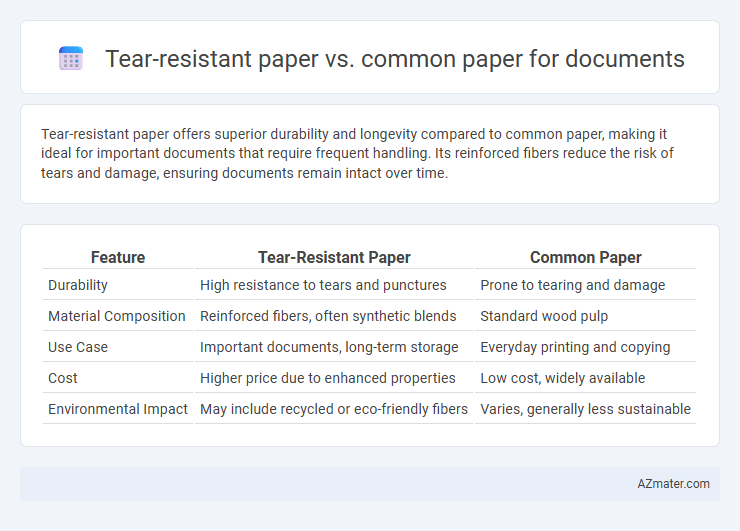Tear-resistant paper offers superior durability and longevity compared to common paper, making it ideal for important documents that require frequent handling. Its reinforced fibers reduce the risk of tears and damage, ensuring documents remain intact over time.
Table of Comparison
| Feature | Tear-Resistant Paper | Common Paper |
|---|---|---|
| Durability | High resistance to tears and punctures | Prone to tearing and damage |
| Material Composition | Reinforced fibers, often synthetic blends | Standard wood pulp |
| Use Case | Important documents, long-term storage | Everyday printing and copying |
| Cost | Higher price due to enhanced properties | Low cost, widely available |
| Environmental Impact | May include recycled or eco-friendly fibers | Varies, generally less sustainable |
Introduction to Tear-Resistant Paper and Common Paper
Tear-resistant paper is engineered with synthetic fibers or reinforced materials to enhance durability and prevent tearing, making it ideal for documents requiring longevity and frequent handling. Common paper, typically made from wood pulp, lacks this reinforcement, resulting in lower strength and higher susceptibility to damage under stress. Understanding the distinct composition and performance characteristics of tear-resistant versus common paper is essential for selecting the appropriate material for secure, long-lasting documentation.
What Is Tear-Resistant Paper?
Tear-resistant paper is specially engineered with fibers that enhance durability and prevent easy tearing, making it ideal for important documents that require long-term preservation and frequent handling. Unlike common paper, which uses standard pulp prone to ripping under stress, tear-resistant paper incorporates synthetic fibers or reinforced coatings to maintain integrity even when subjected to rough use. This type of paper is widely used in legal, archival, and identification documents to ensure longevity and resistance against physical damage.
Composition and Manufacturing Differences
Tear-resistant paper incorporates synthetic fibers such as polyester or polypropylene blended with wood pulp, enhancing durability and resistance to tearing compared to common paper, which primarily consists of cellulose fibers from wood pulp. The manufacturing process of tear-resistant paper involves additional steps like calendaring and coating to improve strength and flexibility, whereas common paper undergoes standard pulping, pressing, and drying without these reinforcements. These compositional and manufacturing differences result in tear-resistant paper being suitable for critical documents requiring longevity and enhanced physical integrity.
Key Features of Tear-Resistant Paper
Tear-resistant paper is designed with high-density fibers and synthetic materials that enhance durability and prevent easy tearing, making it ideal for important documents subject to frequent handling. It offers increased resistance to water, abrasion, and punctures compared to common paper, ensuring longevity and maintaining document integrity in various environments. Its compatibility with standard printers and archival quality further distinguishes it as a superior choice for secure, long-lasting records.
Durability and Longevity Comparison
Tear-resistant paper demonstrates significantly higher durability compared to common paper, featuring reinforced fibers that prevent easy tearing and withstand frequent handling. Its longevity surpasses standard paper, maintaining structural integrity and legibility over time, making it ideal for important documents and archival purposes. Common paper tends to degrade faster under stress and environmental factors, resulting in reduced lifespan and increased risk of damage.
Cost Analysis: Tear-Resistant vs Common Paper
Tear-resistant paper typically incurs higher upfront costs than common paper due to specialized manufacturing processes and added durability features. However, its increased lifespan and reduced replacement frequency can result in long-term savings for businesses handling high-volume or archival documents. Common paper remains more cost-effective for short-term or low-durability needs but may lead to higher cumulative expenses when frequent reprints or document preservation are necessary.
Applications in Document Protection
Tear-resistant paper enhances document protection by providing superior durability against physical damage such as ripping and tearing, making it ideal for frequently handled documents like ID cards, certificates, and legal papers. Common paper, while cost-effective and widely used, lacks the structural integrity needed for long-term preservation or high-security applications. Utilizing tear-resistant paper significantly reduces maintenance and replacement costs in environments requiring robust document protection.
Environmental Considerations
Tear-resistant paper, often composed of synthetic fibers or reinforced materials, offers extended durability and reduces the frequency of document replacement, resulting in less paper waste compared to common paper made from traditional wood pulp. Despite its longer lifecycle, tear-resistant paper may involve more energy-intensive manufacturing processes and can be less biodegradable, posing disposal challenges in conventional recycling streams. Choosing between tear-resistant and common paper requires balancing durability benefits with environmental impact assessments, including lifecycle carbon footprint and end-of-life recyclability.
User Experiences and Case Studies
Tear-resistant paper enhances durability in document handling, reducing damage in high-traffic environments such as legal offices and outdoor fieldwork, according to multiple case studies highlighting up to 80% fewer replacements compared to common paper. Users consistently report improved satisfaction due to the paper's resistance to ripping, moisture, and frequent folding, which preserves document integrity during transport and repeated use. These benefits result in cost savings and increased efficiency, particularly in sectors requiring long-term document preservation like healthcare, logistics, and government administration.
Conclusion: Which Paper Type Is Better for Important Documents?
Tear-resistant paper offers superior durability and security, making it ideal for important documents requiring long-term preservation and resistance to physical damage. Common paper, while cost-effective and widely available, lacks the robustness necessary to prevent wear and accidental tearing over time. For critical documents such as legal contracts, certificates, and archival records, tear-resistant paper is the better choice to ensure longevity and integrity.

Infographic: Tear-resistant paper vs Common paper for Document
 azmater.com
azmater.com